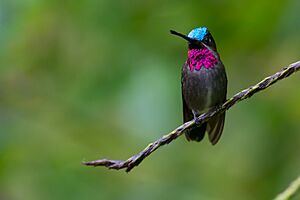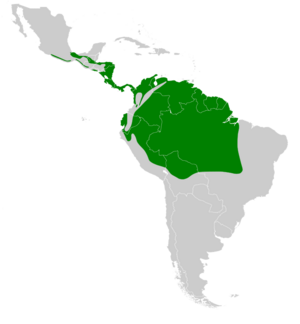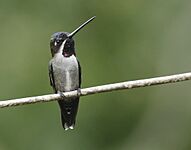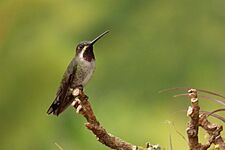Long-billed starthroat facts for kids
Quick facts for kids Long-billed starthroat |
|
|---|---|
 |
|
| Conservation status | |
| Scientific classification | |
| Genus: |
Heliomaster
|
| Species: |
longirostris
|
 |
|
| Distribution | |
The long-billed starthroat (Heliomaster longirostris) is a type of hummingbird. It's known for its long bill, which helps it drink nectar from flowers. You can find this bird in Mexico, Central America, Trinidad, and many parts of South America.
Contents
About the Long-billed Starthroat
How Scientists Classify This Bird
For a long time, the long-billed starthroat was placed in a different group of birds. But since the mid-1900s, scientists have agreed it belongs in the Heliomaster genus.
There are three slightly different types, or subspecies, of the long-billed starthroat:
- H. l. longirostris (the main type)
- H. l. pallidicepts
- H. l. albicrissa
What Does the Long-billed Starthroat Look Like?
This hummingbird is about 11 to 12 centimeters (4.3 to 4.7 inches) long. Males usually weigh between 5.5 and 7.1 grams. Females are a bit heavier, around 6.5 grams. Both male and female birds have a long, mostly straight, black bill. They also have a small white spot right behind their eye.
Males of the main subspecies have a shiny blue or greenish-blue head. The rest of their upper body is a dark bronze-green color. They have a white stripe down the middle of their lower back. Their face is black below the head, with a white stripe on their cheek.
Their tail is quite short and has a square shape. The feathers are bronze-green near their body and black further out. The tips of the outer two or three tail feathers are white. The throat is black, and the gorget (a patch of feathers on the throat) is a dark metallic purple. Their chest is gray with bronze-green sides. The lower chest and belly are a dull white.
Female long-billed starthroats look very similar to males. However, the blue on their head is much less noticeable or even missing. Their gorget is also narrower and a dusky gray color.
The subspecies H. l. pallidicepts has a more greenish-blue head than the main type. Its chest sides are a golden bronze color. The H. l. albicrissa subspecies is just like the main type, but its undertail feathers are mostly or entirely white.
Where Do Long-billed Starthroats Live?
The H. l. pallidicepts subspecies lives in the northern parts of the range. You can find it from southern Mexico through Belize, Guatemala, Honduras, and El Salvador, down into Nicaragua.
The main subspecies, H. l. longirostris, is found in the most places. It lives from Costa Rica through Panama. In South America, it goes as far south as eastern Peru and eastern Bolivia. It also lives east through the Guianas and into Brazil, and on the island of Trinidad.
The H. l. albicrissa subspecies lives in a smaller area. It is found in western Ecuador and northwestern Peru.
These hummingbirds live in many different damp, partly open areas. This includes the edges of forests, small groups of trees, and pastures with trees. They also like gallery forest (forests along rivers) and secondary forest (forests that have grown back). They do not like to live deep inside dense forests. They prefer lowlands and foothills, from sea level up to about 1,500 meters (4,900 feet) high.
How Long-billed Starthroats Behave
Bird Movements and Migration
The movements of the long-billed starthroat are not fully understood. They seem to move around based on when different plants are flowering. This suggests they follow their food sources.
What and How Do They Eat?
Long-billed starthroats mostly eat nectar from flowers. They especially like the flowers of large trees. They also get nectar from vines, shrubs, and Heliconia plants. They find food in two ways:
- Trap-lining: This means they visit a regular route of flowering plants.
- Defending flowers: They will protect trees full of flowers from other birds.
They also eat small insects. They often catch these insects while flying high in the air. Sometimes, they pick insects off plants.
Reproduction and Life Cycle
Long-billed starthroats breed during the late wet season and early dry season in the northern parts of their range. In Mexico and Central America, this is from October or November to February or March. Scientists have seen them raise two groups of babies in Central America during one season. In northern Colombia, they nest in September or October and again in March. The breeding times in other areas are not yet known.
Their nest is a shallow cup. It is made from soft plant fibers, moss, and liverworts. They use spider silk to hold it all together and cover it with lichen. Nests are usually placed between 4.5 and 12 meters (15 to 39 feet) above the ground. They build them in shrubs, on exposed branches, and even on telephone wires.
The female bird sits on the two white eggs for 18 to 19 days. The young birds leave the nest (fledge) about 25 to 26 days after they hatch.
What Sounds Do They Make?
The long-billed starthroat makes several calls. One call is described as a "rich liquid 'tseep' or 'tsew'". They also make "squeaky twitters" when they are chasing other birds.
Conservation Status of the Long-billed Starthroat
The IUCN (International Union for Conservation of Nature) says the long-billed starthroat is a species of "Least Concern." This means it is not currently in danger of disappearing. It lives across a very large area. There are at least 500,000 adult birds. However, the number of birds is thought to be going down.
No immediate major threats have been found for this species. It is considered uncommon in most places where it lives. But it can be found in several protected areas. It seems to be able to handle a lot of changes to its environment. It might even do better when forests are cleared, as long as some scattered trees and small groups of trees remain.
Gallery





